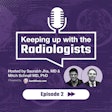
A simple method using flashcards to train undergraduate medical students can help them identify important chest abnormalities in chest x-rays, according to a study published April 3 in the European Journal of Radiology.
Irish researchers explored the use of an educational approach called "Say-All-Fast-Minute-Each-Day-Shuffled," or SAFMEDS, which prompts learners to correctly identify abnormalities in as many flashcards as possible during one-minute trials. The researchers found students using SAFMEDS demonstrated significantly higher accuracy in chest x-ray interpretation compared with a control group that did not.
"Junior doctors find chest radiograph interpretation challenging, and commonly make diagnostic errors ... SAFMEDS offers an effective adjunct to usual teaching," wrote Caoimhe Madden, PhD, a postdoctoral researcher at the National University of Ireland in Galway.
Although radiologists provide the most accurate interpretation of chest x-rays, clinicians in other specialties (e.g., emergency medicine) are often the first to view them. Thus, all physicians should have the ability to accurately identify potential abnormalities, Madden and colleagues wrote.
Moreover, radiology is largely underrepresented in medical school curricula, with medical students reporting poor confidence levels in interpreting chest x-rays, they added.
"There exists a need to enhance teaching at undergraduate level to ensure all graduates are equipped to correctly interpret [chest x-rays]," Madden and colleagues suggested.
SAFMEDS is a behavioral intervention that uses a set of flashcards, each comprising a stimulus on the front (a chest x-ray showing a pleural effusion, for instance) and the desired response printed in text on the back. Learners attempt to correctly identify abnormalities in as many cards as possible during one-minute timed trials. At the end of each trial, the learners record their performance and revise the cards for which an incorrect response was provided.
The method has previously been found to significantly improve a range of clinical skills in undergraduate medical education, including interpreting electrocardiograms and musculoskeletal radiology exams.
In this randomized controlled trial, the researchers split 37 third-year medical students into two groups -- 19 who underwent SAFMED training and 18 who did not -- and afterward compared their abilities to interpret abnormalities on chest x-rays
Nine commonly misdiagnosed conditions considered essential for newly qualified doctors were used in the test sets, including pneumothorax, pleural effusion, pneumonia, neoplastic disease, and pulmonary edema.
The SAFMEDS group was evaluated based on achieving "behavioral fluency," a measure indicating knowledge that is more likely to persist over time, transfer to other settings, and withstand distraction.
The researchers found that participants in the SAFMEDS group had a higher post-test performance in chest x-ray interpretation compared to those in the control group. In addition, a total of 12 participants in the intervention group (63.2%) met the criteria for fluency, according to the findings.
However, an analysis of differences in the retention of test performance between fluent and nonfluent participants revealed no significant differences between the groups, the researchers added.
"Our data demonstrate a clear impact of SAFMEDS on performance but are less conclusive regarding the performance amongst those who achieved behavioral fluency as compared to those that did not," the group wrote.
The researchers stated that their ability to draw conclusions was limited given that the subgroup analyses between fluent and nonfluent participants may have been underpowered, and suggested further research is warranted.
Ultimately, the researchers wrote that they do not consider SAFMEDS to be a panacea, but rather recommend its use as an adjunct teaching method alongside learning activities that equip students with an understanding of important clinical information relating to chest x-ray abnormalities.
"This study demonstrates that SAFMEDS can have a significant impact on medical students' ability to correctly identify [chest x-ray] abnormalities," Madden and colleagues concluded.



















